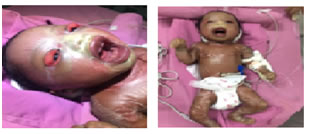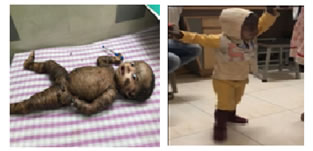Official Journals By StatPerson Publication
|
Table of Content - Volume 9 Issue 1 - January 2019
Use of coconut oil in a case of Lamellar icthyosis
Gargi Chaphekar1, Suhas Kulkarni2*, Nivedita Patil3, Anil Kurane4, Minakshi Balwani5, Suhani Patel6, Nadia Shagufta7
1,5,6,7Resident, 2Associate Professor, 3Professor, 4Professor and HOD, Department of Pediatrics, DY Patil Medical College, Kolhapur, Maharashtra, INDIA. Email: chaphekar.gargi@gmail.com Abstract Lamellar ichthyosis is a rare congenital abnormality and most severe form of congenital ichthyosis. It is autosomal recessive. Most infants are still born or die in infancy. Survival beyond infancy has been possible only rarely.1 Describing a case with lamellar ichthyosis. Key Word: Lamellar ichthyosis.
INTRODUCTION Lamellar Ichthyosis is an autosomal recessive disorder that is apparent at birth and is present throughout life.1,2 The neonate is incased in a collodion membrane that sheds within 10-14 days. Prevalence: Less than 1 in 300, 00 individuals. Equal sex ratio is seen. It affects all races.Pathophysiology: Proliferative hyperkeratosis. Mutation is gene for transglutaminase 1 (TG-1). These mutations cause defects in intercellular lipid layers in the stratum corneum leading to formation of cornified cell envelope. Ectropion occurs only in lamellar type. CASE: B/o Pooja Kharkande was delivered FTLSCS on 19/10/2016, cried immediately after birth. She had scaling of skin, ectropion, eclabium at birth. Maternal history: Pooja Kharkande, 24years female. Family history: second degree consanguinity. No history of any skin disorders in family. Obstetric history: P1L1–female, 4 years, LSCS, oligohydramnios. G2- Present pregnancy, registered at Ichalkaranji. 2 doses TT taken. Ca and hematinics taken. First USG done at 2 months. Anomaly scan was normal. No h/o fever or rash during pregnancy. None of the USG show any anomaly. Birth history- FTLSCS/ BCIAB/ 2.7kg/ female/ 19/10/2016 at 5:20 pm. Congenital skin disease was present with ectropion and eclabium. On examination: Figure 1: Ectropion and eclabium and pseudocontractures, Figure 2: Skin changes Baby was active and crying with Heart rate of 135/min, Respiratory Rate of 36/min, SpO2- 94% Peripheral pulses were well felt, Anterior Frontanelle wasflat, Capillary Refill Time was < 3 secs. Shiny taut membrane was seen covering the entire body with cracks present over folds. Erosion was noted over the anterior aspect of neck. Hair over the head was sparse. Eyes: Bilateral ectropion of upper and lower eyelids was noted. Congestion over upper and lower palpebral conjunctiva was present. There was flattening of nose and ears. Lips: Eclabium was present. Pseudo contracture of all joints were present. CVS- S1S2 normal. No murmur. RS- Breath sounds bilaterally symmetrical and clear. PA- Soft, no organomegally. Bowel sounds present. CNS- Suck, grasp present. Moro’s normal. Management: We kept baby under humidifier as hyperkeratosis interferes with sweat gland function, leading to impaired thermoregulation. Investigations included serial sepsis and electrolyte monitored. Minimum friction was maintained. IV fluids were started. Nasogastric feeds were gradually increased. Antibiotic prophylaxis with Amoxiclav and Amikacin was given. Emollient was applied on the skin. Eye care was done with to bramycin eye drops, lubrex eye drops, plastic protective eye shield. Baby was discharged on 8th day of life with parental counselling. Parents started using coconut oil instead of moisturizer after discharging due to financial issues. She survived and is 2 years old now with isolated motor developmental delay, all other milestones are normal. Figure 1: At 6 months, rolled over. walking with support, Figure 2: At 2 years, CONCLUSION Diagnosis of collodion baby is clinical, and management is conservative. Since baby is susceptible to infection, minimal handling and asepsis should be maintained.4One should not hesitate to upgrade antibiotics depending on the septic screening. Management is team work of pediatrician, dermatologist and ophthalmologist.5 Coconut oil gave similar results to moisturizer. Though this case has very low survival rate, with supportive treatment and proper care baby can lead an average life.
DISCUSSION It is an autosomal recessive disorder. There's history of 1st degree consanguinity in 8% cases, our baby is borne out of 3rd degree. 25% are born premature though our child is full term. 51% have affected sibling which is not present in our case. 80% cases have generalized involvement as in our case. There's bilateral ectropion (33%), diminished or absent sweating (10%), nail dystrophies (5%)3 - not in our case. Follicular orifices are filled with keratin and hair follicles and sebaceous glands are smaller than normal. There is universal agreement regarding management of such cases with plain ointments and in severe cases steroids, here in this case coconut oil application has given good results. Coconut oil application is a traditionally accepted method in India. There is universal agreement regarding management of such cases with plain ointments, here in this case coconut oil application has given good results. Coconut oil application is a traditionally accepted method in India. Topical application has been shown to reduce trans-epidermal water loss (TEWL) in preterm neonates.6 Coconut oil has been used in preterm which showed increase in weight by better thermoregulation7
REFERENCES
|
|
 Home
Home


